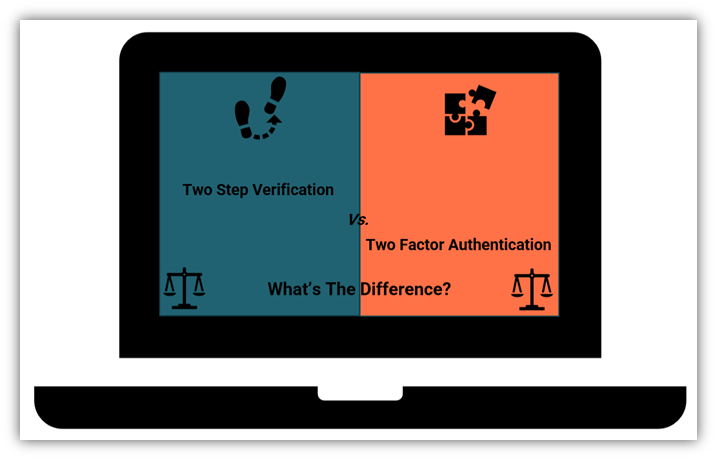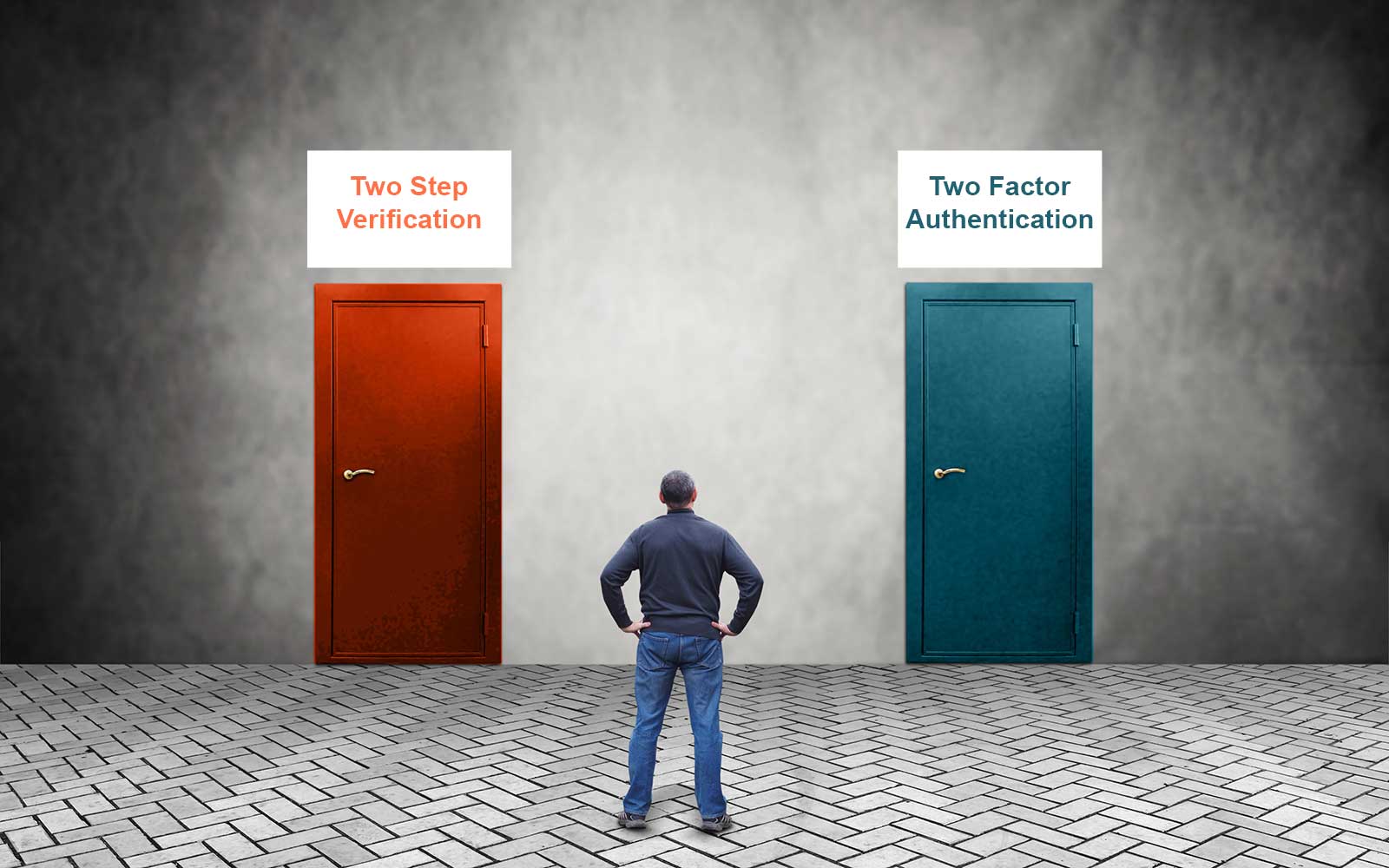The Ponemon Institute & Keeper Security observed that 31% of the organizations don’t require their remote workers to use authentication methods to access company records, while 40% use two-factor authentication. This article will cover the difference between two step verification vs two factor authentication to help you choose the best security method for your systems
A user on a well-known hacker forum released a 100GB text document dubbed RockYou2021 containing 8.5 million unique password entries— each of which is 6-20 characters long passwords. This incident exposes that even long passwords can be vulnerable if the wrong person gets their hands on them. So, what can you do to make your accounts more secure? The answer is to use an additional layer of security on your accounts — namely two factor authentication (2FA) or two step verification (2SV).
However, the question remains: 2 step verification vs 2 factor authentication — what’s the difference? Why and how is one more beneficial than the other in terms of use applications? Let’s explore both of these concepts in more detail.
Breaking Down 2 Factor Authentication vs 2 Step Verification (2FA vs 2SV)

When it comes to understanding the difference between two step verification and two factor authentication (which we’ll write as “2 factor authentication vs 2 step verification” throughout this article), you first need to understand the meaning of the two terms.
- Both phrases describe security protocols that add layers of security to the authentication process beyond what using just a traditional username and password combination provides. (Using traditional login credentials alone is what’s known as single-factor authentication, or SFA.)
- Both terms involve the use of tangible and intangible items that are known as authentication factors. These factors are physical items or bits of knowledge that prove a user is who they say they are (i.e., that they’re not imposters). We’ll discuss these knowledge factors more momentarily.
But the way these two verification processes accomplish this differ in terms of how this additional security layer is appended. And as a result of this difference, companies have their preferences between 2SV and 2FA. But before we get into anything else, let’s first quickly define the two terms.
What Is 2 Step Verification? A Definition
As the name implies, two step verification is a two-step process that some security systems employ as a way to verify the identity of a user (authenticate) before granting them access to a secure system. This typically involves identifying two bits of information that the user knows — such as a password and a one-time PIN (OTP) you receive via SMS text message.
2SV is the next step up from traditional single-factor authentication, which requires a user to enter their username and password alone to access their account. Essentially, 2SV takes SFA to the next level.
What Is Two Factor Authentication? A Definition
Two factor authentication, on the other hand, is a separate authentication process that involves using two separate identifying “factors” to authenticate the user. Factors are things that people know, possess, or are attributes that are inherent to them as individuals — for example, a user could use a password as one factor and then plug in a USB cryptographic token as the other. (We’ll explore factors more in depth in just a moment.)
Because of this, 2FA is classified as a type of multi-factor authentication (MFA). However, it’s important to note that not all MFA methods are 2FA. Think of it like a cup of coffee — all cups of coffee are beverages, but not all beverages are coffee.
Basically, the difference here is that two factor authentication involves verifying two different factors of authentication before granting access to anyone. On the contrary, two step verification is authentication of one single authentication factor twice, in two steps.
Let’s explore the three types of authentication factors to provide additional clarity.
A Break Down of the 3 Authentication Factors
There are three types of identifying factors that you can use to verify the identity of your employees or customers before allowing them access to your web apps or secure IT systems.
1. Knowledge – Something You Know

A knowledge factor can be defined as identifying secret information known only to the user that associates them with their account.
Knowledge factor is an indispensable factor of authentication. It can be used in all forms of authentication methods, including SFA, MFA, and 2SV. Both the steps in two step verification protocol are a part of the knowledge factor. Even in the case of two factor authentication, these “secrets” are often used as one of the verification factors.
So, what counts as a knowledge factor? Simple – a secret that you know. But to constitute a factor of authentication, it has to be something known exclusively by you (meaning no one else should know it). Some of the examples of knowledge factors are as follows:
- Unique passwords or passphrases
- One-time PINs (OTPs) that are sent via SMS text messages to your mobile device, and
- Secret question prompt responses (such as “what is your mother’s maiden name?”).
2. Inherence – Something You Are

An inherence factor is a way to verify a person’s identity by a natural characteristic of an individual for granting access to their account. It is almost impossible to imitate a person’s genetic characteristics like facial profiles or fingerprints. Literally, no two people — not even identical twins that have identical genes — have the same fingerprints. So, including these characteristics to identify a person’s legitimacy becomes a solid factor of authentication.
Before a few years, using such technology was pretty pricey, and thus, providing the scanners for recognition to ordinary people was impossible. With the evolution of technology, scanners have become smaller and more affordable and can be used in most regularly used devices.
The inherence factor is sometimes used as the second factor option in two factor authentication. It enhances the security of the system by verifying the identity of the individual accessing it. Some mobile devices use a face scanner or fingerprint scanner as the only factor for authentication. If this authentication fails, the system resorts to the knowledge factor for granting access.
Possession – Something You Have

A possession factor refers to something you have — a type of tangible item that proves you control of your device. This factor of authentication takes into account the basic idea that you, and nobody else, should be in possession of the hardware registered for authentication. So, the user may enter their username and password and then use a possession factor as their second identifier in the authentication process.
Some examples of possession factors include:
- OTPs generated by authenticator apps on your mobile device,
- RSA hardware tokens, and
- Company ID cards (such as smart cards).
Why Adding Security Layers of Security Matters to Your Business & Customers
Okay, so now you know what both of these authentication processes are, let’s answer another important question: why is either of them necessary? Using traditional passwords alone aren’t enough when it comes to ensuring you have strong account security — after all, passwords are compromised every day via phishing scams, data breaches and leaks.
Although the FBI recommends internet users switch to using passphrases instead of passwords to strengthen their security, doing that isn’t going to do you much good if the password becomes compromised. This is why using either 2FA or 2SV is better than using passwords alone — it adds another layer to the security of your users’ accounts, which enhances the security of your IT environment as a whole.
For obvious reasons, when comparing two step verification vs two factor authentication, the security is much tighter in 2FA as it is more difficult for a bad guy to get hold of two factors than stealing one factor. Although there is no security method that’s 100% safe in the cyberworld, we can say that in comparing 2 factor authentication vs 2 step verification, 2FA is the clear winner as far as security is concerned.
Now that we know what 2FA and 2SV are and why they matter, let’s explore some of the differences between them in terms of applications for businesses.
Difference Between 2SV vs 2FA in Business Applications
Whether you use 2SV or 2FA, both will expect you to verify your identity twice. Both the protocols have similar difficulty levels for the users. Comparing both the methods from the perspective of the enterprise is like comparing apples and oranges. All the companies need different levels of security according to their business models and security needs, and you need to decide whether the juice is worth the squeeze in terms of effort for users.
For instance, a customer might be willing to go the extra length to protect their bank account online but might not be willing to go through the same steps to protect his online gaming account. So, it partly depends on how sensitive the information in your account is that you want to protect.
2SV Streamlines Authentication for Users
Two step verification allows you to choose trusted devices. You can use 2SV once and can log in every other time by just entering your password on these trusted devices. So, you can log in much quicker on your trusted device. You can also turn on the location factor where you can let the system track you on GPS, and if you are in a registered location, you can log in without the need for the second step for verification.
Say you have registered your home or office as your trusted location; you will not have to go to the second verification step for accessing your system. In a nutshell, 2SV allows you to have single-factor authentication (SFA) if you have allowed it on:
- A trusted device
- A trusted location
Having said that, saving time for security is a double-edged sword. If you have turned on the location factor and the person sitting next to you tries to hack into your account, they will only have to hack into one-step verification. If your trusted device is stolen, all hell will break loose for you. This is the biggest drawback of a faster 2SV.
On one hand 2SV streamlines the authentication for the user. There’s no doubt it is much better than single factor authentication. On the other hand, 2FA doesn’t allow you to have SFA anytime. So, if you have 2FA, you will have to follow all the steps to access your accounts. Although this might sound harsh, the fact remains that you have to actively participate in securing your accounts, and it takes time and energy to do so.
2FA Improves Security by Requiring More Than “Secrets”
Two step verification uses two knowledge factors (i.e., secrets like passwords) rather than using mixed factors. For example, one of the critical steps of two step verification is receiving an OTP to the device. Contrary to the popular misconception, SMS-based OTPs aren’t possession factors; rather, they’re knowledge factors because:
- They don’t require physical access to or control of a device, and
- SMS text messages can be intercepted and are susceptible to SIM swapping attacks.
The major advantage of two factor authentication vs two step verification is that the former takes into account the two different types of factors — such as a knowledge factor and a possession factor, or a possession factor and an inherent factor. When two different factors are verified, the chances of somebody impersonating the legitimate user are negligible. A user can also select the factor they want to use depending on the sensitivity of the account. This makes 2FA a much more secure way to protect your account.
2FA Allows Companies to Use Third-Party Authenticator Apps
While comparing 2SV and 2FA, one of the things that differentiates them is the flexibility each method offers to its users. 2SV provides hardly any elbow room to the users. Not all carriers are compatible with 2SV as they do not send the SMS PIN to the user. As a result, 2SV will fail. The user is locked out of their accounts, and he will have to take steps to gain entry some other way. This essentially means a higher load on the support desk of the company.
On the contrary, two factor authentication gives the user option to use third-party authentication apps, including Google Authenticator, Authy, or Microsoft Authenticator. These authenticator apps have time-based one-time passwords for allowing access to accounts. Authenticator apps don’t require an internet or network connection to work (because the code is generated within the app on your individual device), therefore, it becomes a very convenient option for all types of users. Moreover, the authenticator apps work under an independent realm and don’t give access to other apps on your device. Hence, the bad guys can’t intercept other apps to steal the passwords.
Final Words on 2 Factor Authentication vs 2 Step Verification
Two-step verification and two-factor authentication are methods that add extra security to your IT environment by enhancing your authentication systems. There are pros and cons to both methods, and as a business owner, you must decide which method best serves the needs of your organization and your customers.
As a user, the choice of whether to use 2FA vs 2SV isn’t up to you as the website owner has to make that decision. However, the choice you do have is whether you want to enable the available security feature on your accounts.



![A 6-Minute Overview of the PCI DSS Requirements [For PCI DSS v.4.0]](https://cheapsslsecurity.com/blog/wp-content/uploads/2022/12/pci-dss-requirements-v4-370x245.jpg)

